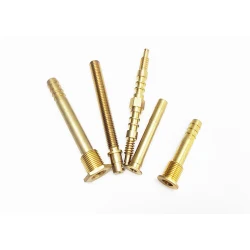Key Components of CNC Machining
2024-06-07
CNC (Computer Numerical Control) machining is a manufacturing process in which pre-programmed computer software dictates the movement of factory tools and machinery. Here's a detailed overview of CNC machining parts:
Key Components of CNC Machining
1. Workpiece: The material being machined, which can be metal, plastic, wood, or composite.
2. Machine Tools: The devices used for machining the workpiece, such as lathes, mills, routers, and grinders.
3. Cutting Tools: Various tools used for cutting, drilling, milling, and turning, made from materials like high-speed steel (HSS), carbide, or diamond.
4. Control System: The computer and software that control the CNC machine. It interprets the CAD (Computer-Aided Design) file and converts it into G-code, the language used to control the machine's movements.
5. Spindle: The part of the machine that holds the cutting tool and rotates it at various speeds, providing the necessary cutting force.
6. Chuck or Collet: Devices that hold the workpiece in place during machining.
7. Axes: CNC machines operate along multiple axes. Common configurations include 3-axis, 4-axis, and 5-axis machines, which allow for complex and precise machining.
8. Drive System: Motors and other components that move the machine along its axes. This includes stepper motors, servo motors, and linear actuators.
CNC Machining Process
1. Design: The part is designed using CAD software.
2. Programming: The CAD file is converted into G-code using CAM (Computer-Aided Manufacturing) software.
3. Setup: The workpiece is fixed in the machine, and the tools are set up.
4. Machining: The machine executes the G-code, shaping the workpiece into the desired part.
5. Finishing: Secondary processes like deburring, sanding, or surface finishing are performed to achieve the final specifications.
Advantages of CNC Machining
- Precision: High accuracy in manufacturing complex parts.
- Repeatability: Consistent quality in mass production.
- Flexibility: Easily adaptable to new designs by updating the program.
- Efficiency: Faster production times compared to manual machining.
Applications
- Aerospace: Components for aircraft and spacecraft.
- Automotive: Engine parts, transmission components, and custom car parts.
- Medical: Surgical instruments, prosthetics, and implants.
- Electronics: Housings, connectors, and heat sinks.
- Industrial: Tools, molds, and machine parts.
Considerations for CNC Machining
- Material: Different materials require different cutting tools and parameters.
- Tool Wear: Regular monitoring and replacement of tools to maintain precision.
- Complexity: More complex parts may require advanced machines with more axes.
- Cost: Initial setup and programming can be expensive, but it becomes cost-effective in large-scale production.
Examples of CNC Machined Parts
1. Engine Block: Typically machined from aluminum or iron, used in automotive and aerospace engines.
2. Gearbox Housing: Precision machined for automotive or industrial applications.
3. Heat Sink: Aluminum parts used in electronics for dissipating heat.
4. Custom Brackets: Used in various applications for mounting and support.
5. Prosthetic Components: Custom parts for medical use, designed for individual patients.
CNC machining is a versatile and essential technology in modern manufacturing, providing high precision, repeatability, and efficiency in producing complex parts.



